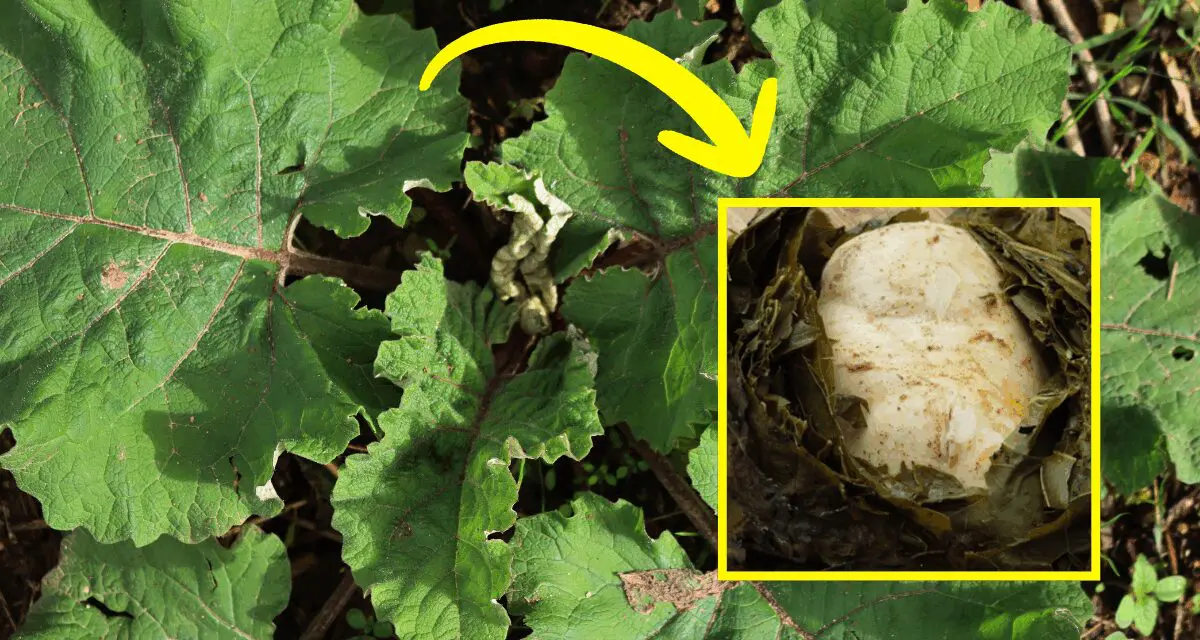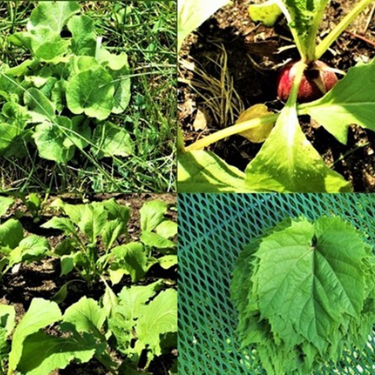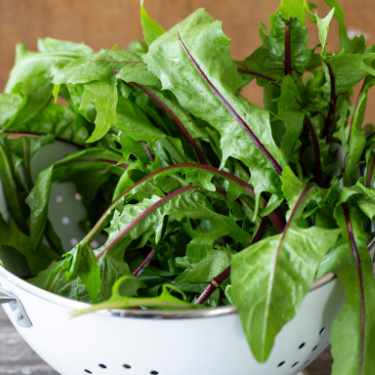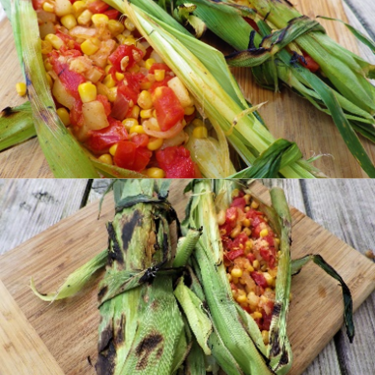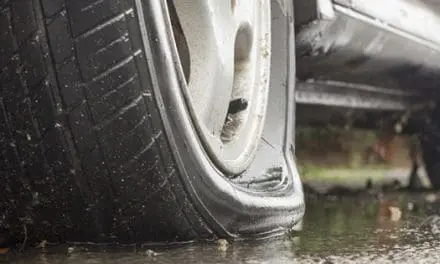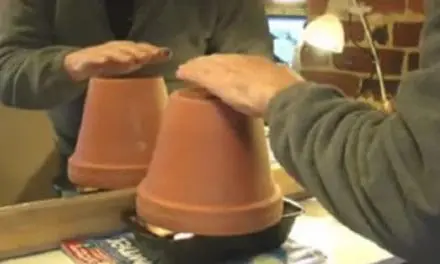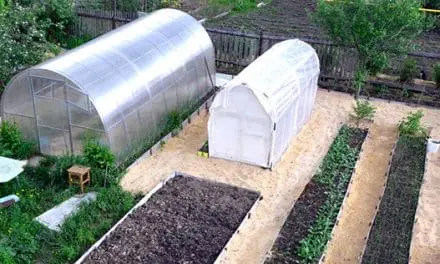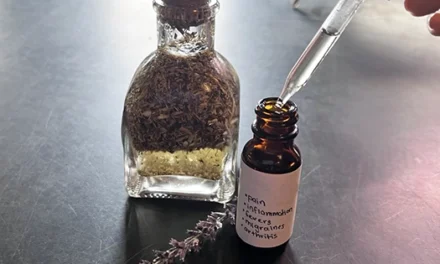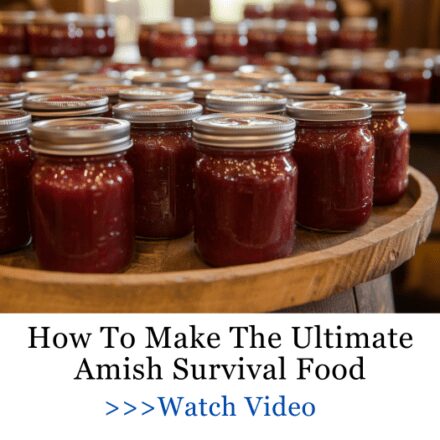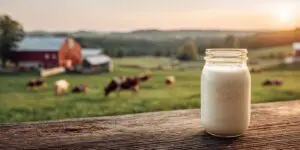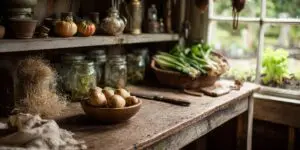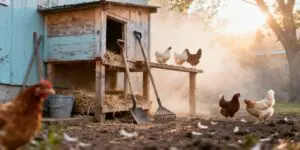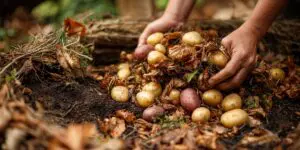Back in the day, people didn’t have foil or fancy bakeware. If you wanted to cook something over the fire, you used what was around, and that often meant…leaves. It sounds strange at first, but wrapping food in leaves and cooking it right in the coals was a common practice across much of early America.
Native tribes did it. Pioneer families did it. Some people in the Appalachians still do it. And it turns out, there are some real benefits to cooking this way, especially if you’re living off the land or trying to cut back on store-bought supplies.
Cooking in leaves keeps food moist, adds flavor, and doesn’t leave you with anything to throw away. It’s simple, natural, and honestly… kind of fun once you get the hang of it. If you’ve got cabbage in the garden, grapevines climbing the fence, or a patch of burdock out back, you’ve already got what you need to give it a try.
So let’s take a look at what happens when you cook your food in leaves, and why this old weird trick might be worth bringing back to your homestead.
Why Leaves?
Cooking food in leaves is an ancient tradition. Long before metal pots, pans and griddles, leaves allowed food to be cooked over open coals without burning or covering the food in ash. The food was usually wrapped in the leaves in multiple layers, and the leaves were often steamed or parboiled to make them more flexible.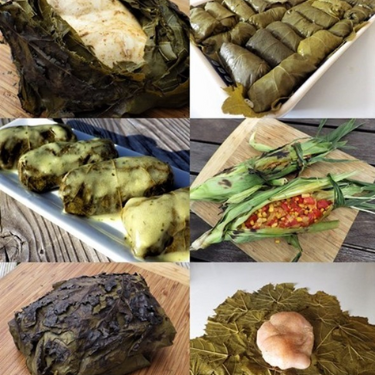
Just about anything could be cooked in leaves, including meats, fish and seafood like shrimp and clams, and even a mix of other vegetables.
Cooking in leaves might seem unusual now, but it’s been done here in America for hundreds, if not thousands of years. Native tribes used leaves like corn husks, wild ginger, and even bark to wrap food before cooking it in pits or over coals. It helped keep things from burning, locked in moisture, and sometimes added a bit of flavor too.
Later on, settlers and pioneers picked up the habit. In the Appalachian hills, it wasn’t uncommon to see meals wrapped in cabbage leaves and tucked into a cast iron pan or right into the embers of a fire. It made use of whatever was growing nearby, and it sure beat scrubbing burnt-on food off a pot.
Even during tough times like the Great Depression, families also leaned on simple tricks like this, making do with what they had and keeping meals hearty and filling without spending a dime on kitchen gadgets or disposable supplies.
What Leaves You Can Actually Cook With
Not all leaves are safe to cook with, but plenty are, especially the ones you might already be growing in your garden or finding around your homestead.
The number one consideration when harvesting leaves for cooking is whether or not the plant itself is edible and safe to eat. And it’s not just about traditional fruits and vegetables. Many plants that we think of as weeds are not only edible, but also produce large leaves ideal for wrapping and cooking. Here’s a short list of leaves to consider for wrapping foods or as additions to a leaf-wrapped recipe:
Cabbage Leaves
Good old cabbage leaves are one of the easiest to use. They’re sturdy, wide, and flexible enough to wrap around meat, beans, or root vegetables. You can use them in a cast iron pan or wrap them in foil or bark for cooking over a fire.
Corn Husks
If you grow corn, save the outer husks. Native tribes and early settlers used them for cooking everything from dumplings to meat. Just soak them in warm water first so they don’t burn too quickly.
Grape Leaves
If you’ve got wild or cultivated grapevines, the young leaves are perfect for wrapping food. They hold up well to heat and add a slightly tangy flavor to whatever you’re cooking.
Maple Leaves
The softer, younger maple leaves can work in a pinch. They’re not as flexible as cabbage or grape, but they make a nice layer in a Dutch oven or around root vegetables roasting in coals.
Chestnut Leaves
Used traditionally in the Appalachian region, these broad, tough leaves are great for wrapping dough, fish, or small game before baking.
Dock or Burdock Leaves
If you’ve got these “weeds” growing wild, don’t be so quick to yank them out. Their large leaves were often used by old-timers to cook food in pits or line pots.
Plantain Leaves
These wide, ribbed leaves grow just about everywhere. They’re best used for steaming or layering in cast iron, and they’re also known for their soothing, skin-healing properties.
One of the old-time remedies I’ve used with plantain is a fever compress. It helps draw out heat and brings a cooling, calming effect when someone’s running a temperature. It’s especially useful when you don’t have much on hand. You can learn how to make it here.
Dandelion Leaves
Young, tender dandelion leaves can be used to wrap smaller items, especially in a pinch. They’re not very big, so you might need several, but they’re everywhere and totally safe to use.
But dandelions aren’t good just for cooking. They’re also one of the best backyard plants for everyday health. The leaves support kidney health and digestion, while the roots are often used in a restorative liver tea or brewed into a bitter tonic to ease indigestion. I’ve even made a dandelion lemonade that’s great for the gallbladder. The flowers can be turned into a soothing salve for sore muscles and joints, and if you know what you’re doing, you can even make an “Amish ibuprofen” out of the whole plant.
If you’re short on time or just want something ready to go, this Liver Blend Tincture is a good one to keep on hand. It’s made with dandelion root, milk thistle and other herbs that help your body feel lighter and more balanced, especially when your system’s been working overtime. It helps flush out toxins, supports digestion, and gives your liver a break when you’re feeling sluggish, bloated, or just plain off.
Palm Leaves (If you live down South)
In the southern U.S., some homesteaders have used young palmetto or palm leaves to wrap food for steaming or roasting. Just be sure you’re using an edible species, and always test with a small amount first.
Leaves to Avoid
Some leaves are downright dangerous to cook with, even if they grow in the garden. Avoid the following:
- Rhubarb leaves – poisonous due to high oxalic acid content. Never use them.
- Tomato, potato, and eggplant leaves – part of the nightshade family. Toxic.
- Stone fruit tree leaves (like cherry, peach, apricot) – can contain cyanogenic compounds.
- Oleander – ornamental, but extremely toxic. Never use near food or fire.
If you’re not 100% sure what a plant is, don’t risk it. When in doubt, leave it out or look it up in a trusted field guide.
American Fire Cooking Methods Using Leaves
If you ever had to cook without a stove or oven, knowing how to use leaves and fire together is a skill that could make all the difference. I also found a lot of other off-grid solutions, like the no-electricity fridge, the Amish root cellar, and even a water filter that works without power in the Amish Ways book. Honestly, I wish more people knew about stuff like this; it’s a game-changer for any homesteader.
For the first time ever, this 200-year-old wisdom is available in a beautifully made hardcover edition, authored by Eddie Swartzentruber, a man who spent 16 years living within the Amish community and learning their way of life first-hand. You can grab your own copy today and claim 3 FREE BONUSES using my exclusive 76% discount coupon right here.
Here are some tried-and-true American ways to cook food using nothing but fire and what you’ve got on hand:
1. Cooking in the Coals (Pioneer-Style)
This is one of the oldest methods out there, used by Native tribes, settlers, and anyone who’s cooked over an open fire. 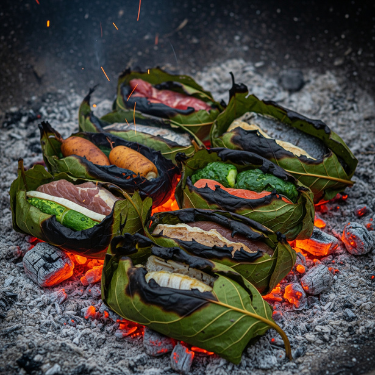 Simply wrap your food tightly in leaves (like cabbage or grape), then tuck the bundle into hot coals. Use a stick or shovel to cover it lightly with ash and embers. Interestingly, ash isn’t just useful for cooking. It has also been used for centuries to help clean wounds and speed healing. But to make it work right, you’ve got to know this little trick that makes it work almost instantly.
Simply wrap your food tightly in leaves (like cabbage or grape), then tuck the bundle into hot coals. Use a stick or shovel to cover it lightly with ash and embers. Interestingly, ash isn’t just useful for cooking. It has also been used for centuries to help clean wounds and speed healing. But to make it work right, you’ve got to know this little trick that makes it work almost instantly.
I also found out that Navy SEALs and the British SAS even keep a piece of coal in their pockets when they’re out in the wild or on missions. The reason stuck with me, and knowing it could change the way you handle survival too. But that’s a story for another time. Or you can uncover it for yourself right now by clicking here.
This method works best for:
- Fish
- Potatoes or root vegetables
- Wild game
- Canned beans and rice
Tip: Double-wrap your food with two layers of leaves if the fire’s extra hot. Some people used a layer of bark over the leaves to protect them even more.
2. Pit Cooking (Used by Native Tribes Across North America)
Dig a shallow pit, line it with hot stones, and lay down a layer of moist leaves.
Place your leaf-wrapped food on top, add another layer of leaves, then cover the whole thing with dirt or more coals. Let it slow-cook for a few hours.
This is suitable for:
- Larger cuts of meat (like rabbit or squirrel)
- Hearty meals with multiple ingredients
- Cooking for a group off-grid
The heat from the stones and the insulation from the leaves create a natural oven, great for long, slow cooking without electricity.
3. Cast Iron + Leaves Combo (Appalachian Style)
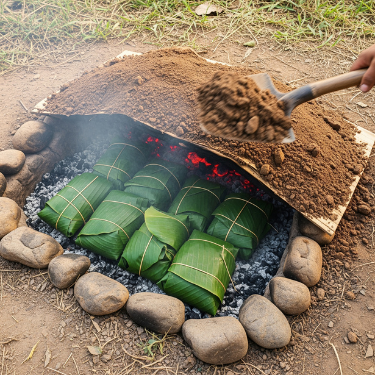
If you’ve got a cast iron skillet or Dutch oven, you can still use leaves to line it or wrap food inside before setting it near the fire or on coals.
You can use this for:
- Leaf-lined cornbread or biscuits
- Beans wrapped in corn husks
- Stuffed cabbage rolls
- Reheating leftovers
Bonus: The leaves help prevent sticking and make clean-up easier, something our great-grandmothers appreciated when water was scarce.
4. Rock Wrapping (Cowboy and Trapper Method)
Wrap food in leaves and wedge it between two heated flat stones, then place the bundle near the fire. This works especially well when you’re cooking small meals or don’t want to deal with digging a pit.
- Jerky-soaked beans
- Trout or other small fish
- Tightly packed grain cakes
Tip: Let the stones heat up slowly near the fire first. Don’t throw cold rocks into flames, or they might crack.
Basic Leaf Prep
The first step after harvesting your leaves is to wash and rinse them in cold water to remove any dust, debris, insect dropping and all the other stuff that drifts through the air. Stack them in bowl or on a plate and you’re ready for the next step.
Steam or Parboil the Leaves
You can use a standard steamer setup to steam your leaves for a few minutes or drop them into boiling water for 2 minutes and then shock them in ice water. All your trying to do is make them flexible so they can easy be wrapped around food or rolled up. Let them cool if you haven’t shocked them in ice water and handle them gently. They will be somewhat tender and can rip easily.
The next step is cook something, and we’re going to start with some recipe ideas.
Amish Corn Husk Bean Pone
Bean pone (cornmeal and bean pudding) is a traditional Amish side or dessert. Cornmeal and dried beans store for years; when prepared, the dish can be wrapped in corn husks and cooked or reheated over coals or in a Dutch oven.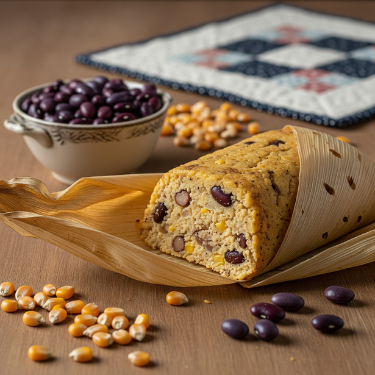
Ingredients:
Cornmeal
Cooked mashed beans (such as navy or pinto beans)
Maple syrup or honey (optional sweetener)
Soaked corn husks
How to make it:
Mix cornmeal with mashed beans and a little sweetener, spoon onto husks, wrap tightly, and steam or bake in a Dutch oven. This dish is hearty and shelf-friendly when the dry ingredients are stored properly.
Chicken Grilled in Grape Leaves
You can roast any cut of meat or fish with this style of cooking and you can cook it over coals or in the oven.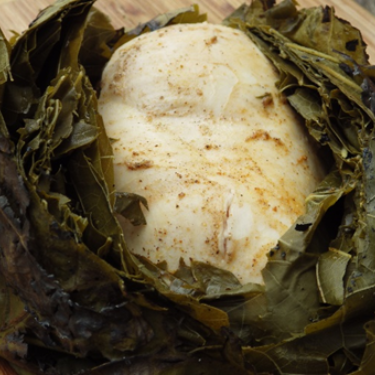
- Prep about 3 to 5 dozen grape leaves by dropping into boiling water for a minute and then shocking them in ice water or iced vinegar for 10 minutes. You could also steam them.
- Spread the leaves out on a surface while overlapping the leaves and placing them in layers to create about 5 to 10 layers. Make sure you have enough leaves spread out to wrap the cut of meat. About 8 to 12 inches should work.
- Season the meat any way you like although seasoned salt is a good place to start.
- Wrap the cut of meat by folding up and overlapping the leaves.
- Bake at 350 degrees F. for 45 minutes or grill over coals for 20 minutes a side. The leaves will char especially over coals. You could also place the leaf package directly on the coals if you want to cook in a very primitive style.
- Unwrap the leaves and you can use the leaf package as a plate if you like.
Cowboy Cornbread Wrapped in Corn Husks
Cornbread was a campfire staple for cowboys on the trail. It was simple, filling, and easy to cook wrapped in corn husks or leaves over coals. While fresh cornbread doesn’t keep long, the dry ingredients (cornmeal, flour) last for years, and cornbread can be baked ahead, wrapped, and frozen or vacuum-sealed for longer storage.
Ingredients:
Cornmeal (long-lasting pantry staple)
Baking powder
Salt (if you don’t want to depend on store-bought salt, I found out how you can extract it in minutes from some really common backyard plants from this book)
Water or buttermilk powder + water
Rendered bacon fat or lard
How to make it:
Mix ingredients, spoon batter onto soaked corn husks, wrap tightly, and cook buried in hot coals or next to the fire until firm and golden. The husks protect the bread and add subtle corn flavor.
Dutch Oven Beans Wrapped in Cabbage Leaves
Beans and cabbage were cornerstone foods for cowboys and settlers alike. Beans (dried or canned) keep for years, and cabbage (fresh or fermented as sauerkraut) was a hardy vegetable that could be preserved in root cellars or barrels. Wrapping beans in cabbage leaves before cooking in a Dutch oven or over coals helps lock in moisture.
Ingredients:
Dry beans or canned beans
Salt pork or cured bacon
Onions and seasoning
Large cabbage leaves
Steps:
Soak and cook beans slowly with salt pork for flavor, then wrap portions in cabbage leaves and reheat wrapped over coals or in a Dutch oven. This method keeps beans moist and adds flavor without extra pans or foil.
Trail-Ration Meat and Potato Packets in Corn Husks
Cowboys often carried salted or cured meats and dried potatoes on the trail. Wrapping these together in corn husks and cooking over coals made for a hot, hearty meal with minimal fuss.
Ingredients:
Salted or canned beef/pork
Dried potatoes (rehydrated or pre-cooked)
Onions or dried herbs
Corn husks
Optional: chopped veggies
How to Cook:
Rehydrate potatoes if needed, mix with diced meat and seasoning, wrap tightly in soaked corn husks, and cook buried in hot coals for 30-40 minutes.
How to Preserve Leaf-Cooked Foods for the Long Haul
The best way to make your leaf-cooked meals last is to combine this cooking method with tried-and-true preservation techniques that homesteaders have trusted for generations. After cooking your food wrapped in leaves, like cabbage or corn husks, take the leaves off and pack the food into clean jars for canning. For meals with meat or other low-acid ingredients, pressure canning is the safest method. Done right, it can keep your food good for years, perfect for storing in your pantry without refrigeration.
Another way to save your food for later is by drying it. Some leafy greens or herbs you cook with can be dried for tea or seasoning, and when stored in airtight containers, they’ll stay good for a long time. If you have the ability to freeze food, maybe with solar power or a generator, freezing cooked meals after removing the leaves will also help them keep for months. Vacuum-sealing before freezing will make them last even longer.
Fermenting is an old-time method that the Amish have used for ages. Think sauerkraut made from cabbage. Fermented veggies can last for months and give you a tasty, healthy treat through the winter. You can even use fresh leaves to wrap portions of your fermented veggies when cooking.
Wherever you store your preserved foods, keep them in a cool, dark, and dry spot, like a root cellar or pantry. Heat, sunlight, and moisture are the enemies of good food storage, so airtight containers like glass jars or vacuum-sealed bags help keep your food safe and fresh. Labelling your jars with dates and using your oldest foods first will keep your pantry rotation smooth.
With these methods, you can expect your canned meals to stay good for a few years, dried herbs and veggies for several years, frozen food for up to a year, and fermented foods for several months. Just remember to always follow safe canning rules, especially for meats, to avoid any health risks.
The Concept is Simple
Once you understand the concept of cooking with leaves it’s easy to extend it to other ingredients including seafood, fruits and even a blend of vegetables and meats. Just remember to only use leaves from plants that are safe to eat, steam or boil the leaves so they easily wrap around your food, and if cooking over open coals use more leaves to protect the food. You may be surprised how well this works and how tender and moist everything will be when you cook in leaves.
Ingenious Ways to Freeze-Dry Your Food at Home for 10+ Years Shelf Life
Why The Amish Keep Eggs Covered in Salt (Video)

